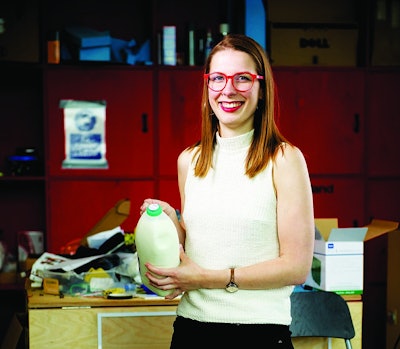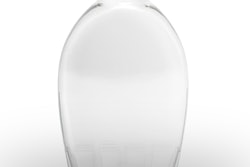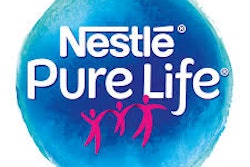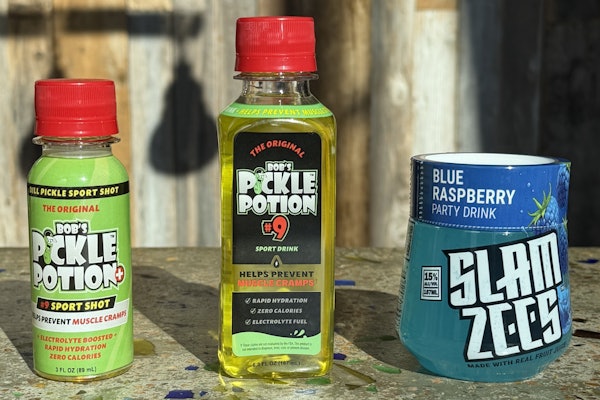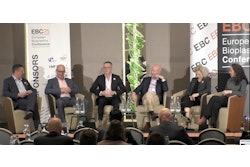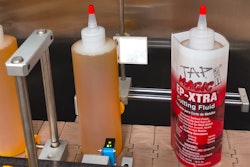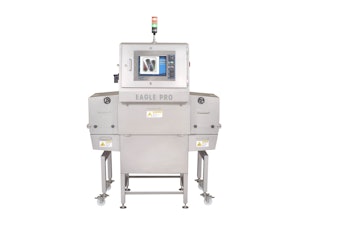Solveiga Pakstaite is ready to disrupt the food and beverage packaging industry. The industrial designer is set to launch a bioresponsive, tactile food expiration label that she says is more accurate in determining food spoilage than conventional sell-by dates and will ultimately reduce the growing problem of food waste.
Scheduled to launch in March in the United Kingdom, the Mimica Touch is a gelatin-based label that changes texture as food decays. When the gelatin in the label is smooth and solid, the food is still edible and safe. But when the food spoils, the gelatin becomes soft and liquefies. The label then reveals a bumpy surface that a consumer can feel with the swipe of a finger.
“It’s a label that acts in the same way as food does, which is why we’re calling it bioresponsive,” says Pakstaite, founder and CEO of London, England-based Mimica. “It’s a label that basically experiences decay at the same rate as food. It gives a completely accurate picture of when food spoils.”
The Mimica Touch label consists of four layers: The bottom plastic film with a one-way membrane serves as the foundation of the label. A plastic sheet with ridges, which provides the bumpy texture, is placed on the plastic film. Then gelatin is topped on the textured plastic sheet. Finally, the entire label is sealed with a plastic film on top.
The key component of the Mimica Touch label is the proprietary gelatin formula, which is made from animal bones. Because the gelatin is created from a protein-based food byproduct, it decays at the same rate as protein-based foods like meats and dairy products. When the food starts to spoil, the bacteria releases volatile compounds that travel through the one-way membrane in the bottom plastic film in the label. That off-gassing breaks down the bonds of the gelatin and turns the gelatin into a liquid, allowing consumers to feel the bumpy texture of the label. The company alters the concentration of the gelatin based on the type of food the label is monitoring.
Pakstaite came up with the idea for the Mimica Touch when she was a student majoring in industrial design at Brunel University in London in 2014. As part of a class project, she discovered that many blind people prefer frozen and processed foods over fresh foods because they can’t gauge when fresh foods spoil.
“I was initially inspired by looking at an old banana that was turning brown and floppy. The skin was changing,” Pakstaite says. “Basically, I was wondering why our plastic packaging couldn’t do the same. That’s where the idea behind this texture-changing label that degrades at the same rate of food came from.”
Pakstaite expects the Mimica Touch will not only help visually-impaired people accurately assess when their food has spoiled, but also the general public, who throw out edible food based on conservative sell-by dates. “In the U.K., at least 60 percent of the food that we throw away is still perfectly edible, which definitely points the blame to expiry dates being overcautious,” she says.
Manufacturers use food dates to indicate freshness and when the product is at its peak. Most foods don’t necessarily spoil by those dates. Yet many people toss out foods based on those dates. As a result, the Food and Agriculture Organization of the United Nations finds that about one-third of the food produced in the world for human consumption goes to waste annually — that’s 1.3 billion tons a year.
Mimica Touch’s impact on food waste and food safety will be put to the test when it rolls out this spring. Pakstaite declines to name the U.K. manufacturers that will use the Mimica Touch until the deals are finalized. The labels will be used on packaging for meats, milk and other protein-based products.
In the meantime, the company is also working on developing the Mimica Touch for other food groups and creating a plant-based version of the gelatin to accommodate vegetarians and vegans.
“[Mimica Touch] has the potential to disrupt a really old industry. Expiry dates entered the industry in the 1970s, and it’s pretty much been the standard since then. If you think about how much the world has moved on in terms of other technology, it’s kind of astonishing that we’re still using the same system to monitor our most valuable resource, which is food,” Pakstaite says.
